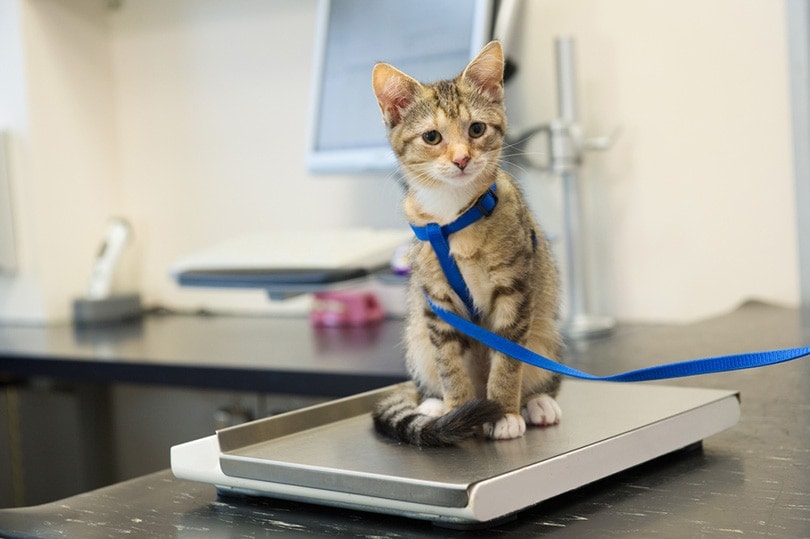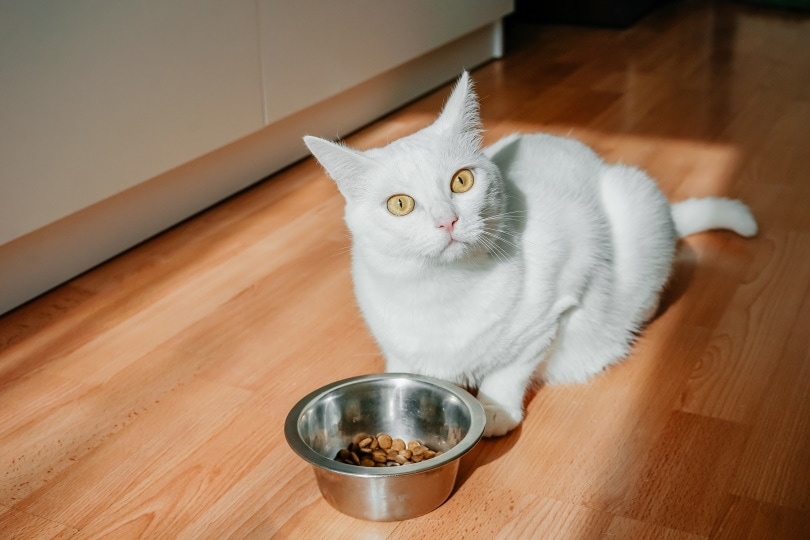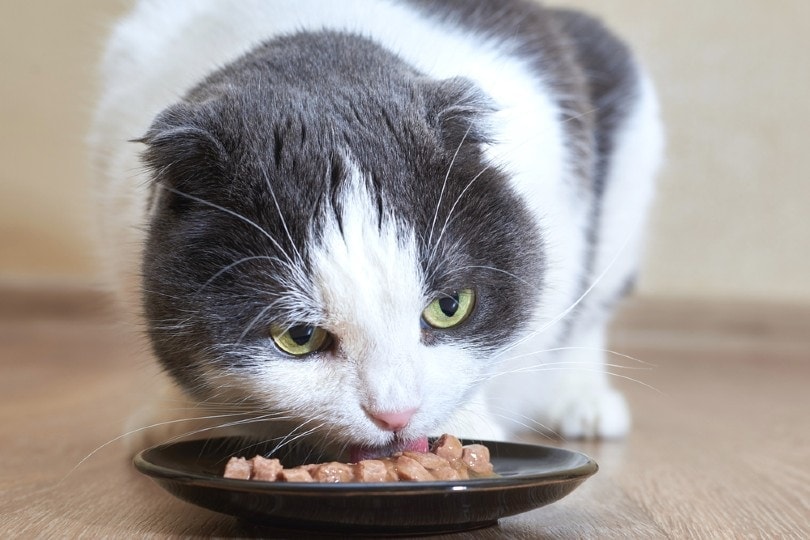Your Cat’s Weight: What Is a Healthy Range
Let’s start by stating that, as in the case of humans, cats need to be in a certain weight range to remain healthy and thrive. A cat that is malnourished and too thin is unhealthy and more prone to disease. However, a cat that is overweight is unhealthy and more prone to disease. With this in mind, you only want to fatten up a truly underweight cat to help it reach a healthy weight and be able to thrive in its daily activities. Trending photos and videos on social media of obese cats do not represent healthy cats, even if some people think they look cute or funny. As responsible cat owners, we should never allow our cats to become overweight because this will have serious consequences on their health. With all that being said, let’s learn about healthy ways to fatten up a cat that needs to put on some weight.

Ruling Out Medical Conditions
First things first, we need to rule out the possibility of the cat being underweight as a result of a medical condition or underlying disease. If the cat is underweight, it is recommended to visit a veterinarian and get the cat checked as many medical conditions can cause low weight. Some of the most common are:
1. Dental Problems
The pain caused by teeth or any injury in the mouth makes eating unpleasant and your cat will avoid it as much as possible.
2. Parasites
Intestinal parasites are a common find in underweight animals as they rob the host of many essential nutriets.
3. Food Allergies or Sensitivities
Certain food may not be ideal for your cat and make him feel unwell.
4. Infections
Needless to say, the animal will not be food-driven if feeling unwell and fighting an infection.
5. Hyperthyroidism
This endocrine disease causes cats to lose weight and is more common each day due to the phytoestrogens from soy used as a protein base in many formulations of commercial cat food.
6. Inflammatory Bowel Disease
Anxiety, sensitivities, intolerances can all cause IBS in a cat. Pain and discomfort from this condition may be the reason the cat is refusing to eat and thus losing weight. A veterinarian will make a complete physical evaluation of the cat and might need to collect biological samples such as blood or feces. If the vet discovers that the reason the cat is not eating or not putting weight is actually due to a medical condition, they will provide accurate treatment and a specific diet accordingly. Make sure to cooperate with the veterinarian and follow all the instructions regarding diet and treatment.

Review of Other Factors
Once you have ruled out the possibility of the cat suffering from a medical condition, you should check for other factors that could be the cause of their malnourishment:
1. Quality of Their Current Diet
Cats are obligate carnivores and require a diet based mostly on animal proteins with a moderate amount of fat and very limited carbohydrates. The quality of the base protein source in your cat’s diet is very important for their overall health. The amino acids derived from the protein source are the building blocks of your cat’s muscle tissue and maintenance of the vital organs. Unlike herbivores or omnivores, carnivores cannot survive only on vegetable sources of protein, they cannot produce essential amino acids such as taurine and arginine and rely only on their diet to obtain them.
A premium cat diet should have an animal protein as a base product and should ideally not contain vegetable products or only a minimal amount. This is a challenge since most commercial cat food formulas contain vegetables because plant proteins are cheaper than meat proteins. Pet food companies will have a higher profit margin when using corn, wheat, soy, rice, soy, or peas. Another problem with the vegetable sources is that the number of carbohydrates in the diet will be increased, and cats are not supposed to have more than 10% of carbohydrates in their diet. You want to make sure that the base protein source is animal protein and not vegetable protein. Try to stick with whole protein as a base versus a “meal protein”; these by-products tend to be highly processed and lose nutritional quality. This is why it is very important to feed premium products and to check the ingredient labels carefully.

2. Environmental Factors
It is important to be aware of the possibility of a cat refusing to eat due to environmental factors, and some detective work and observation will be necessary to rule out this possibility.
- Their food bowl is near a noisy area or loud machines such as a dishwasher or a laundry machine.
- The plate is near the litter box, this one is a BIG no, no. This is very unhygienic but is somehow still a common practice.
- There are other cats showing dominance over others, not allowing them to eat. As a general rule, each cat should have their own plate. But, in some cases, even this is not enough, and the animals must be completely separated in different rooms or have different meal times.
- Anxiety can cause loss of appetite. Investigating the cause of the anxiety in your cat and addressing it accordingly can go a long way in helping your pet put on weight and regain their mental health.
- Your cat may be a “shy eater” and needs privacy to eat. Some cats do not like to be seen by an anxious human when they are feeding.
- Perhaps you recently changed the cat’s food and his body does not agree with the new choice. Changes in food must be done gradually, mixing the usual food with the new one in gradually increased percentages over 10 days or so. Start with as little as 10% of the new food and increase by the same increment each day. Reports of cats refusing to eat even after small formula changes by the pet food producers are not unheard of.

8 Tips to Fatten a Cat the Healthy Way
Now that we have ruled out the possibility of medical and environmental factors here are some tips to fatten a cat the healthy way.
1. Use Kitten Canned Food
Kitten canned food is higher in the amount of protein and fat per gram than the canned food made for adult cats. This is because kittens are growing and they need the additional source of amino acids and fatty acids to build up their growing muscles and organs.

2. Prefer Canned or Wet Food Over Dry Food
In general, canned or wet food is higher in protein and lower in carbohydrates than dry food. As well, cats seem to accept it more readily than dry food, especially those that are having trouble finding an appetite.
3. Increase the Food Amount Gradually
Do not expect your cat to eat the goal amount of food for weight gain in one go. Sometimes dividing the day’s diet into many small feeds is the way to go until you can gradually increase the amount of food in each feed session and decrease the number of feeding sessions.
4. Supplement Fish Oil
Fish oil is an excellent way of increasing the calorie content in the cat’s food with the additional benefits of enhancing the cat’s food flavor and making the cat’s fur look healthy and shiny. It is an excellent source of healthy omega fatty acids. We love GNC’s salmon fish oil and Animal Essentials Ocean Supreme Fish Oil Dog & Cat Supplement.
5. Offer Healthy Homemade Treats and Prices
Offering pieces of boiled chicken or boiled egg is a great way to increase the cat’s caloric intake. It is important to remember to keep these foods only boiled with water and not fried, with no salt or any other condiment added. You can use them as a reward for finishing the goal target meal or mix them with the food to enhance the flavor. If your cat is accepting its meals normally, you can use them as treats between the meals.

6. Make The Food More Attractive
Some cats can be very fussy and you will need to use your imagination to sneak in more calories. Things like using the broth from the boiled chicken (remember, only boiled—no added salt or condiments) to your cat’s food, playing with the consistency, the presentation or shape and the temperature of the food are all resources you can try. Many cats begin accepting food after it has been prewarmed. If you think about the fact that a freshly-hunted prey in the wild has a certain temperature, it makes sense that cats would prefer their meals a bit on the warm side, right? Just remember, don’t offer it too hot! If your cat gets burned, all your efforts can be lost as it will make their weary of trying your next meal.
7. Have More Than One Option
Just like us some cats just don’t like certain recipes, choose more than one kind of high-quality cat food and by trial and error, land on one your cat likes and accepts the best. An easy way to know is by offering different kinds of food all at once and seeing if your cat has any particular preference.
8. Keep An Eye On Sensitivities and Intolerances
Sensitivities and intolerances to certain foods or components of a formula can be the reason why a cat is eating less and losing weight. These sensitivities can develop later so food that used to be accepted and digested by the body previously may now be making your cat feel unwell. Gas and bloating, smelly gas and feces, unformed or loose feces, diarrhea, and vomit are all signs that you should further investigate your cat’s food.

Final Thoughts
We hope you find these recommendations useful in helping your cat put on some weight and recover a healthy range to thrive. With some observations, dedication, and following our advice, you should be able to increase the number of daily calories ingested by your cat. Over time, the cat should put on some weight the healthy way!
Featured Image Credit: Inge Wallumrød, Pexels






